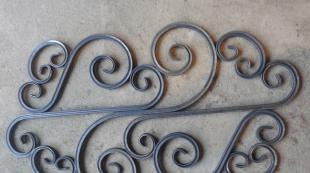Do-it-yourself brick rocket stove drawings. Jet thrust on guard of cozy warmth: do-it-yourself rocket stove
This unusual type of heating systems is not familiar to ordinary developers. Many professional stove-makers have also never encountered such designs. This is not surprising, since the idea of a rocket stove came to us from America relatively recently, and today enthusiasts are trying to bring it to the mass consciousness of citizens.
Due to the simplicity and low cost of construction, thermal comfort and high efficiency rocket stoves deserve a separate article, which we decided to devote to them.
How does a rocket oven work?
Despite the loud space name, this heating structure has nothing to do with rocket systems. The only external effect that gives some resemblance is a jet of flame that escapes from vertical pipe at the marching version of the rocket stove.
The work of this hearth is based on two basic principles:
- Direct combustion - the free flow of fuel gases through the furnace channels without being stimulated by the draft created by the chimney.
- Post-combustion of flue gases released during the combustion of wood (pyrolysis).
The simplest jet furnace works on the principle of direct combustion. To achieve thermal decomposition of wood (pyrolysis), its design does not allow. To do this, it is necessary to perform a powerful heat-accumulating coating of the outer casing and high-quality thermal insulation of the inner pipe.

Despite this, portable rocket stoves perform their functions well. They don't require a lot of power. The generated heat is enough for cooking and heating in the tent.
Rocket furnace designs
To begin acquaintance with any design should be with its simplest options. Therefore, we present a diagram of the operation of a mobile rocket stove (Fig. 1). It clearly shows that the firebox and the combustion chamber are combined in one segment. steel pipe, bent up.
For laying firewood, a plate is welded in the lower part of the pipe, under which there is an air hole. Ash, which plays the role of a heat insulator, helps to enhance heat transfer in the cooking zone. It is poured into the lower part of the outer casing.

The secondary chamber (casing) can be made from a metal barrel, bucket, or an old gas cylinder.
In addition to metal, the simplest rocket furnace can be built from several dozen bricks even without the use of mortar. A firebox and a vertical chamber are laid out of them. Dishes are placed on its walls so that there is a gap under the bottom for the exit of flue gases (Fig. 2).

A prerequisite for the good operation of such a design is a “warm pipe”, as the stove-makers say. In practice, this means that before laying firewood, the rocket stove must be warmed up for several minutes, burning wood chips and paper in it. After the pipe is warmed up, the firewood is stacked in the firebox and set on fire, a powerful upward flow of hot gases appears in the furnace channel.
The fuel loading in simple designs of rocket furnaces is horizontal. This is not very convenient, because it forces you to periodically push the firewood into the firebox as it burns out. Therefore, in stationary systems, a vertical bookmark is used, and air is supplied from below through a special blower (Fig. 3).

Burning out, the firewood itself falls into the oven, saving the owner from manual feeding.
Main dimensions
A visual representation of the configuration of a stationary rocket furnace long burning gives drawing #1.

Anyone who wants to build a stationary rocket furnace, without being distracted by simplified modifications, must know its basic dimensions. All dimensions of this design are tied to the diameter (D) of the cap (drum) covering the vertical part of the flame tube (riser). The second dimension required for calculations is the area cross section(S) cap.
Based on the two indicated values, the remaining dimensions of the furnace structure are calculated:
- The cap height H is between 1.5 and 2D.
- The height of its clay coating is 2/3H.
- Coating thickness - 1/3D.
- The cross-sectional area of the flame tube is 5-6% of the cap area (S).
- The size of the gap between the cap cover and the upper edge of the flame tube should not be less than 7 cm.
- The length of the horizontal section of the flame tube must be equal to the height of the vertical one. Their cross-sectional areas are the same.
- The blower area should be 50% of the cross-sectional area of the flame tube. To ensure a stable operation of the furnace, experts recommend making a flame channel from a rectangular metal pipe with an aspect ratio of 1:2. She is laid flat.
- The volume of the ash pan at the exit from the furnace into the external horizontal smoke channel must be at least 5% of the volume of the cap (drum).
- The external chimney must have a cross-sectional area between 1.5 and 2S.
- The thickness of the adobe insulation pad, which is made under the external chimney, is chosen in the range from 50 to 70 mm.
- The thickness of the adobe coating of the bench is chosen equal to 0.25D (for a drum with a diameter of 600 mm) and 0.5D for a cap with a diameter of 300 mm.
- The external chimney must be at least 4 meters high.
- The length of the flue in the bed depends on the diameter of the cap. If it is made from a 200-liter barrel (diameter 60 cm), then you can make a bed up to 6 meters long. If the cap is made of a gas cylinder (diameter 30 cm), then the bench should not be longer than 4 meters.
When building a stationary rocket furnace, special attention must be paid to the quality of the lining of the vertical section of the flame tube (riser). To do this, you can use refractory bricks of the ShL brand (light fireclay) or washed river sand. To protect the lining from flue gases, it is made in a metal shell, using old buckets or a galvanized sheet for this.




Sand filling is done in layers. Each layer is compacted and lightly sprayed with water. After making 5-6 layers, they are given a week to dry. It is easier to make thermal protection from fireclay, but the space between the outer shell and the brick will also have to be covered with sand so that there are no empty cavities (Fig. 4).

Figure No. 4 scheme of the lining of the flame channels of rocket furnaces
After the backfill has dried, the upper edge of the lining is coated with clay, and only after that the installation of the jet rocket furnace is continued.
Advantages and disadvantages of rocket stoves
An important advantage of a properly constructed structure is omnivorousness. Such a stove can be fired with any kind of solid fuel and wood waste. Moreover, the moisture content of wood does not play a special role here. If someone claims that such a stove can only work on well-dried wood, then this means that gross mistakes were made during its construction.

The heat output of the rocket furnace, which is based on a barrel drum, is very impressive and reaches 18 kW. A gas cylinder stove is able to develop thermal power up to 10 kW. This is quite enough for heating a room with an area of 16-20 m2. We also note that the adjustment of the power of rocket furnaces is carried out only by changing the volume of loaded fuel. It is impossible to change the heat transfer by supplying air. The blower adjustment is used only to enter the furnace into operating mode.

Since the amount of heat generated by the rocket oven is very large, it is not a sin to use it for household needs such as heating food (on the drum lid). But it is impossible to use such a hearth to heat water used in a radiator heating system. Any introduction of coils and registers into the furnace design adversely affects its operation, worsening or stopping the pyrolysis process.
Useful advice: before you start building a stationary jet furnace, make a simplified camp structure from metal or clay. So you will work out the basic assembly techniques and get useful experience.
The disadvantages of rocket stoves include the impossibility of their use in baths and garages. Their design is designed for energy storage and long-term heating. Therefore, it cannot give a lot of heat in a short period of time, as is necessary in the steam room. For garages that store fuels and lubricants, an open flame oven is also not the best option.
We assemble a rocket stove with our own hands
The easiest way is to assemble a camping-garden version of a jet stove. To do this, you do not have to purchase masonry materials and prepare adobe for coating.
A few metal buckets, a stainless steel pipe for the flame channel and small gravel for backfilling - that's all you need in order to make a do-it-yourself rocket furnace.

First step- cutting holes in the lower bucket with scissors for metal to pass the flame tube. It must be done at such a height that there is room under the pipe for crushed stone backfill.
Second step- installation in the lower bucket of a flame tube, consisting of two elbows: a short boot and a long one for the outlet of gases.
Third step- cutting a hole in the bottom of the upper bucket, which is put on the lower one. The head of the frying pipe is inserted into it so that its cut is 3-4 cm above the bottom.
Fourth- backfilling with small gravel in the lower bucket at half its height. It is needed for heat accumulation and thermal insulation of the flame channel.
Last step- production of a stand for dishes. It can be welded from round reinforcement with a diameter of 8-10 mm.
A more complex, but at the same time durable, powerful and aesthetic version of the rocket stove requires the use of a gas cylinder and a thick rectangular steel pipe.

The assembly scheme does not change. The exhaust gas here is organized on the side, and not at the top. For cooking, the upper part with a valve is cut off from the cylinder and a flat round plate 4-5 mm thick is welded in its place.
Unfortunately, in our country, almost no one knows about the rocket stove. Meanwhile, similar design extremely useful in some cases due to the almost complete absence of soot during operation and high combustion temperature.

Today we will talk about how a do-it-yourself rocket stove is made.
Hot gases instead of a chimney enter a special bell, where they burn out (hence the absence of soot). At the same time, the temperature rises even more, and the pressure, on the contrary, decreases. The cycle is constantly repeated and soon the furnace enters the combustion mode with maximum thrust (the strength of the latter depends on design features and installation quality).

The temperature in the hood can reach 1200ᵒС, as a result of which all waste is burned almost without residue, and the exhaust consists mainly of carbon dioxide and water vapor.
Note! Thanks to this, the chimney can be laid under the floor or through some kind of heating structure (couch, for example, or a bench). What's more, the hot hood can be used for water heating, cooking, fruit drying, etc.

The benefits include:
- high efficiency;
- lack of soot;
- high temperature;
- the possibility of using cones, damp branches, dry plant stems as fuel - at a temperature of 1200ᵒ almost everything burns;
- low fuel consumption - about four times lower than in the standard design.
Types of rocket furnaces
There are several types of rocket (or jet, as they are also called) furnaces.
- Portable structures from tin containers (paint cans, buckets, etc.). Great helpers on the construction site or on a hike that can be made in just a few hours.
- Furnaces made of refractory bricks and metal barrels, intended for heating heat-intensive masses. They feature a horizontal chimney installed underground and an external riser to provide draft.
- Fully brick structures used for floor heating. They consist of several chimneys at once.
Note! Due to the complexity of the implementation of the third option, only the first two will be considered in this article.

In this case, work traditionally begins with the preparation of everything necessary.

Stage 1. Materials and equipment
For construction you will need:

Stage 2. Preparation
Step 1. A pit is pulled out in the floor (if possible) with a depth of about 30-50 cm. This is necessary so that the level of the horizontal chimney does not rise much.
Step 2. The steel barrel will serve as a cap for the furnace. First, the barrel is fired and cleaned of soot with a metal brush, after which it is painted with refractory paint.
Note! The paint is applied only after the chimney outlet flange is installed.
Stage 3. Foundation
Step 1 Formwork is being prepared for the future foundation.
Step 2. In the place where the firebox will be, several bricks go deep into the ground.
Step 3. Steel reinforcement is laid on the bottom.
Step 4 Bricks are laid around the lower point of the combustion chamber according to the level.
Step 5. The base is poured with concrete mortar.

Stage 4. Masonry
After the mortar has dried, you can proceed to laying the rocket furnace.
Note! To do this, you need to use only refractory clay.
Step 1. On the first tier, the masonry rises, leaving only a hole for the combustion chamber.
Step 2. At the second level, the lower channel of the furnace is formed.






Step 3. On the third channel, it is covered with masonry in such a way that two holes are obtained - for the combustion chamber and the vertical channel.
Note! Bricks after laying can not be hewn - they still have to be hidden with adobe and expanded clay.
Step 4. Preparation for laying the vertical channel. In addition to the barrel itself, this will require an old water heater of about 150 liters.
A flange is built into the barrel for connecting the chimney. Here it is desirable to install a tee for cleaning the chimney.
Step 5. Using the "boot" method, the ascending part of the structure is placed. The internal section of this part should be approximately 18 cm.
Step 6. A cut of the water heater is put on the ascending part, and the voids between the walls are filled with perlite. The upper part of the perlite is sealed with chamotte clay.
Step 7. The base of the furnace is lined with bags filled with sand, the base of the casing is coated with clay. The voids between the bags and the body are filled with expanded clay, after which the base is finished with the same clay.
Step 8. The chimney is connected, an inverted steel barrel is put on the ascending part.
Step 9. A trial run of the furnace is carried out, after which the barrel is painted with fire-resistant paint.

Stage 5. Chimney lining
Step 1. The chimney is lined with sandbags and covered with expanded clay.
Step 2. The construction is given the appropriate shape with the help of fireclay clay.
Note! The rocket furnace needs a lot of oxygen during operation, so it is recommended to run an air duct from the street.
It remains only to install the old barbecue in the neck of the firebox and close it with a lid. The seams are sealed with clay. Everything, the brick rocket oven is ready for operation.













In this design, as in the one described above, the principle of operation is to isolate the fire and direct the thermal energy to the right place.
Stage 1. Preparing everything you need
To prepare a portable rocket stove you will need:
- two tin containers of different diameters;
- a couple of corners;
- steel clamps ø10 cm;
- stainless steel pipe for chimney;
- small-sized crushed stone;
- Bulgarian;
- metal scissors.




In the second bucket - the bottom of the rocket furnace, we cut a hole for the pipe







From the wire we bend the burner for dishes

Stage 2. Assembly of the structure
Step 1. A lid for the structure is made from a smaller bucket. To do this, a hole is made in it for the chimney (the cover is not removed). In this case, it is better to bend the “petals” inward - so the pipe will be more securely fixed.
The lower half of the bucket is cut off with a grinder.
Step 2. A hole is cut in the bottom of the other container for connecting the firebox. The tin is cut with scissors into "petals" and bent inward.
Step 3. The forward flow is assembled from a pipe and a pair of corners. Then the pipe is inserted into the bucket and connected there to the "petals" with a steel clamp. Everything, the forward flow of the rocket furnace is ready.
Step 4. The space between the forward flow and the walls of the bucket is covered with fine gravel. The latter will perform two functions in the design at once - thermal insulation and thermal accumulation.
Step 5. The second bucket (lid) is put on the jet furnace.
Step 6. The burner for dishes is bent from steel wire.
Note! Instead of a burner, you can install three bricks.
Step 7. It remains only to paint the structure with heat-resistant paint (preferably gray or black). For melting, the forward flow outlet will be used.









Rules for the operation of rocket furnaces
Rocket stoves, as well as other long-burning designs, need to be launched at warm pipe. And if for the second version of the furnace this is not so important, then for the first, a cold chimney will only lead to unnecessary burning of fuel. For this reason, the structure needs to be preheated - fired with sawdust, paper, etc.
It is also worth noting that the jet furnace is unable to self-adjust, so at first the blower opens completely, and is covered only after the structure starts to hum strongly. In the future, the supply of oxygen gradually decreases.
About the rocket stove in the bath

Jet wood stove with sun lounger
Many, probably, were interested in the question - is it possible to use a jet furnace in a bath? It would seem that it is possible, because it is quite easy to equip a heater on a tire.
In fact, such a design for a bath is not suitable. For light steam, you first need to warm up the walls, and only then, after a while, the air. For the latter, the furnace must be a source of convection and thermal radiation (IR). This is the problem - in a rocket furnace, convection is clearly distributed, and the design does not provide for losses due to thermal radiation at all.

findings
Be that as it may, but today in the manufacture of rocket furnaces there is more intuition than real accurate calculations, therefore, this is an almost limitless field for creativity.
We also suggest that you familiarize yourself with the video instruction for the manufacture of a rocket furnace.
Video - Do-it-yourself jet oven
Topics dedicated to boilers, home-made stoves and heating equipment are always popular on FORUMHOUSE. No wonder. Indeed, due to the constant rise in energy prices, the difficulties and high cost of connecting to the main gas, many are thinking about finding an alternative to "blue fuel".
Despite the large selection of ready-made factory products, our enthusiasts create their own designs of heating systems. Of particular interest is a solid fuel boiler built by the user of our portal with the nickname Perelesnik. He attracted increased attention, because. its work is based on the principle of operation of a rocket furnace. In this material we will talk about the main stages of the development of the boiler, preceding its construction.
How it all started
Before moving on to the technical features of the boiler, it is worth focusing on the background of its construction.

Perelesnik FOUMHOUSE User
Gas is brought into my house, but from time to time I thought about switching to solid fuel. The only thing that stopped gas heating was profitable, and the transition to firewood was not cost-effective. I heated the house with an electrode boiler with a power of 7 kW, working in conjunction with an air conditioner, which was operated “for heating”. In severe frosts, the house was additionally heated by a gas-fired boiler. And the price of gas has gone up...
It was the increase in the price of gas that became the event that led to the development of the rocket boiler.
Before you go and immediately buy "something" called "solid fuel boiler", Perelesnik began to study the subject. He got acquainted with the list of equipment offered in stores, looked at how the neighbors' boilers work, understood which frequent problems arise, studied the reviews on the Internet.

After brainstorming, a list of requirements appeared that the device must meet - in terms of Perelesnik:
- Possibility of stable operation at power from 2 to 20 kW. This is due to the peculiarities of the climate in the region where the forum member lives. In winter, the temperature can stay around 0°C for a month, and then drop sharply for a week to -25…30°C. In the autumn-spring period the temperature is within +5…+10°C. Because the house also needs to be heated in the off-season, but the maximum power is not required from the boiler, a “flexibly” configurable device is needed.
- The boiler must be "omnivorous", i.e. everything that can burn - firewood, fuel briquettes, coal, waste, etc., including wet fuel, should burn in the furnace.
- The design of the boiler should provide for laying logs with a diameter of up to 20 cm. This will reduce the need for chopping firewood.
- Must work from night to morning on one bookmark of fuel. In severe frost, the number of full fuel loads should not exceed three.
- Complete energy independence. The device must work without the need to connect it to the mains. In the event of a wire break or power outage, work circulation pump(it must pump the coolant) provides a backup power system.

The heating system is selected, depending on the climatic conditions of residence, heat loss at home, the availability of a particular type of fuel, energy prices in your area.
Also among the main requirements for the boiler were listed:
- high efficiency, simple and inexpensive construction chimney;
- small formation of soot and deposits (which means that there is no need for frequent cleaning of the boiler and its efficiency increases);
- safe operation of the boiler under any operating conditions, heat resistance of the units;
- the possibility of additional loading of firewood during the operating mode;
- ease of operation of the boiler when installed in a residential area;
- small weight and dimensions.
The most interesting thing is that it was planned to “put” all these requirements into the budget, not exceeding 500 dollars except for labor costs.
It is enough just to get acquainted with the requirements superficially in order to understand that finding a solid fuel boiler that meets all the items on the list is not an easy task. So Perelesnik decided to go two ways:
- Try to find a finished factory product.
- If unsuccessful, copy the design finished boiler and make it yourself.
During the search and further study of information, both options have disappeared. Due to technical features: the “capriciousness” of working on “wet” wood, the impossibility of working at low power, etc. long-burning pyrolysis boilers did not fit. Also, they were not satisfied with the “home-made products” found on the expanses of the “World Wide Web”. The third option remained - based on their knowledge and experience gained, develop the design of a solid fuel boiler “for themselves”.
Rocket boiler - theory
During your search Perelesnik stumbled upon a rocket furnace, and this design “hooked” him.


Perelesnik
The rocket stove attracted me because it does not require any special chimney for its operation, we can say that it is not needed at all. The rocket stove has excellent traction, and without the use of any fans. Its design provides high-temperature afterburning of furnace gases. It is not demanding on the quality of fuel, it works effectively at different capacities.
The matter remained small - to make a boiler out of the stove. Looking ahead, let's say that almost a year has passed from the idea to the implementation of the furnace "into metal". This included several months in search of the optimal design, calculations, experiments. It took three months to make the boiler itself, but the result was worth it.

It was possible to make a device that met almost all the requirements of the list (with the exception of the fact that it is possible to add fuel only when the previous batch burns down to the state of coal). Moreover, it was possible meet the planned budget, although "stainless steel" was used for the construction of the internal parts and parts of the boiler and home-made heat-resistant ceramics were used.
Perelesnik developed a diagram that clearly shows the principle of operation of his boiler.

To understand why the rocket furnace was chosen as the basis for the boiler, it is worth focusing on the theoretical part.
Rocket furnaces well known. They are built by enthusiasts and do-it-yourselfers around the world. The simplicity of their design, the ability to do without the use of expensive materials, and the great variability of such furnaces are captivating. A rocket stove can be as small as a camp stove (food is cooked on them), made from pieces of metal pipes and cans.

And also a large, heating one, with a massive heat accumulator and a built-in stove bench. Such a "rocket" fits perfectly into the design of a modern cottage.

According to Perelesnik, a great help in the development of his boiler was provided by the book of American authors "Rocket Furnaces". It clearly, and most importantly - simply and intelligibly - explains the basic principles self construction rocket stoves. From this book, the main dimensions and proportions of the "heart" of the rocket boiler were also borrowed - the so-called. "J-pipes".


Perelesnik
The "rocket" creates excellent conditions for combustion. Fuel and furnace gases burn out completely. The resulting heat is not "taken away" until all reactions are completed, and only then it is used.
The advantages and pluses of the "rocket" are derived from the features of its design. At the rocket stove, at the expense of long vertical and additionally insulated channel, the length of the path that the furnace gases pass through increases.
Gases, while passing through an elongated channel, mix with already heated air and acquire a temperature that the best way contributes to all combustion processes. It also burns carbon, which, if underburned, is deposited in the form of soot.
The high efficiency of the "rocket" is ensured due to the fact that the wood is burned out, released during thermal decomposition solid fuel(the so-called pyrolysis).
Due to the large temperature difference that occurs at the inlet and outlet of the vertical pipe channel, a powerful natural draft arises. Accordingly, there will be no need to build a high chimney, which provides draft in conventional furnaces.
It should be noted that the gases entering the smoke channel have a high temperature. So that the energy generated by the furnace does not fly out “into the pipe”, you need to take away part of this heat. To do this, a bench is attached to the rocket furnace, where flue gases are launched through horizontally laid out brick channels. It turns out a heat accumulator. The second option - the oven is complemented by a shirt. From here it is already within easy reach of a solid fuel boiler.
Pushing off from this base, Perelesnik decided - it is necessary to make a boiler that works on the principle of a rocket furnace.
The rocket stove is widely known throughout as a long-burning solid fuel heating structure. To achieve the maximum efficiency had to work hard. A liquid fuel stove is able to give all its energy, but wood is more difficult to process. To unlock the full potential of the tree, a chamber for afterburning gases was equipped in jet furnaces.
The Shirokov-Khramtsov rocket or jet furnace got its name not because of its connection with space. The point is the shape of the device and the noise that is created during operation, reminiscent of the operation of a rocket. But this sound indicates improper use of the oven.
Types of long-burning rocket furnaces:
- Portable (mobile);
- Stationary (for heating).
The most popular rocket model is the Robinson. It is often used on hikes. Thanks to a small portable apparatus, you can understand the principle of operation of jet furnaces. The shape of the oven resembles the letter "L".
If the oven is too noisy and hums during operation, then this mode is inefficient and expensive. Normally, there should be a quiet sound, a little rustling.
The jet furnace has a receiving hopper. This is the horizontal part of the pipe. A thrust arises in the channel itself, it is it that affects the intensity of combustion, which warms up the body. That is why it is advised to limit the supply of oxygen. Otherwise, the firewood will quickly burn out and all the heat will evaporate.

The stove is powered by jet thrust due to the natural flow of hot air. The higher the temperature of the furnace walls, the better the wood burns. This allows you to quickly heat the water in large capacity which is indispensable on a road trip. If you equip the pipe with thermal insulation, then after warming up, you can burn thick logs.
Do-it-yourself rocket stove: advantages, drawings, disadvantages
If desired, the conventional design of the furnace can be improved. So the potbelly stove loses a lot of heat, but by equipping the device with a water circuit or brickwork can solve these problems. For all these manipulations, drawings are made.
Advantages of jet ovens:
- Simple and cost effective design. You can use improvised materials, without significant financial costs. All work can be done by hand, special knowledge and skills are not required.
- You can independently control combustion by choosing the desired intensity.
- High efficiency. In general, it all depends on the quality of the installation. The main thing is to take away the maximum energy from the flue gases.
But such a simple and convenient design has significant drawbacks. So you need to select a special fuel for the potbelly stove. Wet firewood must not be used, otherwise pyrolysis will not occur. The furnace may begin to smoke profusely, and all gases will go into the house. In addition, the rocket furnace requires increased safety requirements.
The most popular portable model is the Robinson rocket stove. It was modified and a grate was added.
Homemade jet stoves are not used for heating baths. They are ineffective in infrared light, which plays an important role in the steam room. Surface structures have a small heating area, so they cannot heat the bath.
Drawings of a jet furnace from a gas cylinder and other types
Long-burning furnaces are divided into stationary and mobile. Mobile stoves are used in hiking, picnics, outdoors for heating and cooking. Stationary used to heat the house, outbuildings, greenhouses, garage. In this case, 4 types of structures are distinguished.
Types of jet furnaces:
- Homemade camp stove made of metal pipes, buckets, cans;
- Reactive design from a gas cylinder;
- Brick oven with a metal container;
- Stove with bed.

The portable structure is equipped with pipe sections. The only difference concerns the installed partition for the ash pan. For the lower part, a grate can be used.
A device from a gas cylinder is more difficult to build, but significantly increases efficiency. For installation of the structure, a barrel or gas cylinder. Firewood in the firebox burns out due to the influx of oxygen by loading through a special window.
The gases burn out in the pipe, which is located inside the structure, due to the supply of secondary air. The effect is enhanced by warming the inner chamber. Hot air is placed in the hood, and then into the outer chamber. The products of combustion are removed through the chimney.
To create draft, the top of the chimney is placed 4 cm above the loading window.
The combined brick and metal model is a stationary structure. Due to the high heat capacity, the wood stove accumulates and releases heat for several hours. That is why this design is used to heat residential premises.
A rocket assembly with a bed is an advanced device that is able to retain heat longer. Since part of the heat exits through the chimney, we increased its length. Due to the rapid excision of hot gases and a larger chimney, this problem was solved.
This is how massive stoves with a stove bench are obtained, which are similar to a sofa or bed. This stationary devices from brick or stone. Thanks to its unique design, the stove is able to retain heat all night.
Do-it-yourself drawings of the Ognivo stove and other models
It is best to make small portable structures with your own hands: the Flint and Robinson rockets. It is easy to perform the calculation, and it will require trimming to work profile pipes and metal welding skills. Dimensions may differ from the drawing, it's not scary. It's important to keep the proportions.
To increase the intensity of combustion, it is advised to add improvised nozzles to the design. Secondary air for afterburning will flow there.
Stationary rocket stoves are made from a gas cylinder or a metal barrel. These elements act as a body. Inside, the stove is equipped with smaller pipes or fireclay bricks. From the cylinder, you can make both a stationary unit and a mobile one.
Scheme of a continuous combustion furnace:
- Chimney;
- Cap;
- insulation;
- loading bunker;
- Burning zone;
- Afterburning zone.
23.jpg)
It can be difficult to calculate a rocket furnace, because there is no exact methodology. You should pay attention to the checked finished drawings. It is necessary to determine the size of the heating equipment for a particular room.
Assembling a do-it-yourself jet furnace for heating
The construction of the furnace begins with preparatory work. First you need to decide on the place of construction. It is chosen based on the requirements that apply to solid fuel structures: wood or coal.
When you have decided on a place, you need to properly prepare it for construction. The wooden floor under the stove is dismantled. They dig a small pit and tamp the bottom.
In a small room, a jet furnace is placed in the corner. The loading bunker occupies one side, and the lounger the other.
The barrel or cylinder must also be prepared for installation. To do this, they cut off the lid and the tap. Then the structure is cleaned. Next, prepare the solution.
Stages of construction of a jet furnace with a bench:
- The bottom of the dug pit is laid out with fireclay bricks. Formwork is made along the contour of the recess. Perform reinforcement.
- Lay out the base and pour concrete. After a day, when the concrete hardens, further work begins.
- The base of the stove is laid out from fireclay bricks. Raise the side walls, make the lower channel.
- The combustion chamber is covered with brick. There are two holes on the sides. One is for the firebox, the second is for the vertical pipe (riser).
- The metal case is equipped with a flange into which the horizontal channel of the stove will enter. All seams must be airtight, well sealed.
- A side outlet is attached to the horizontal pipe, which serves as an ash pan.
- A fire tube is made of brick. As a rule, it is square.
- The flame tube is equipped with a casing. The gaps are filled with perlite.
- Installation of the cap is made from the cut off part of the barrel or cylinder. It is equipped with a handle.
- Equip the furnace body with brick or stone.
- Equip the front of the furnace. Lay out the necessary contour.
- A prepared barrel is placed on the base. lower part must be sealed with clay.
- With the help of a corrugated pipe, a channel is formed that connects the firebox with the street.
- The pipes of the heat exchanger are connected to the lower pipe.
- Install a chimney. All elements must be sealed using asbestos cord and refractory coating.

Advanced Water Loop Rocket Furnace
A long-burning cauldron can be obtained by equipping a furnace with a water jacket. Water heating may not be efficient enough. The fact is that the main part of the warm air enters the room and is packed into hobs. To create a rocket cauldron, it is necessary to give up the possibility of cooking on a stove.
Materials required for equipping a stove with a water circuit:
- fireclay bricks and masonry mortar;
- Steel pipe (diameter 7 cm);
- Barrel or balloon;
- insulation;
- Sheet steel and a barrel of a smaller diameter than for the hull to create a water jacket;
- Chimney (diameter 10 cm);
- Details for the heat accumulator (tank, pipes, connecting pipe).
A characteristic feature of rocket furnaces with a water circuit is that the insulation of the vertical part ensures the combustion of pyrolysis gases. In this case, warm air is sent to the coil with a water circuit and gives off heat to the stove. Even when all the fuel has burned out, warm air will still be supplied to the heating circuit.
Do-it-yourself rocket furnace drawings (video)
Jet oven stove benches are widely known among the people. They were used even by Korea, China, England and the population of Japan. The Chinese stove differed from the rest in the ability to heat the entire floor. But the Russian counterpart is in no way inferior. Thanks to useful innovations, the stove is able to keep heat for a long time.
Examples of a rocket stove (photo ideas)

















Among the heating devices, the rocket stove deserves special attention. It has an original structure, which implies the use available materials and components. Virtually anyone can organize one. It is enough to understand how drawings are read, as well as be able to use basic construction tools and materials.
Do-it-yourself rocket stove manufacturing option
Despite the simplicity of the design, the rocket oven involves the use of two principles of operation at once:
- free flow of wood gases through the channels;
- Pyrolysis is the afterburning of gases that are released during combustion.
The simplest rocket stove uses only the first principle of operation, since there are not enough conditions for pyrolysis.
 Neat DIY Rocket Stove
Neat DIY Rocket Stove First, consider the options for jet stoves used for cooking. In such a device, a short pipe is used as a firebox, located horizontally, and then it goes up. This is the simplest design.
The fuel is loaded into the rocket stove directly into the pipe, after which it is ignited. As a result, a stream of hot gases is formed, which is oriented to go outside, which means it tends to a vertical section.
At the cut of the pipe is placed a container used for water or food. There is a gap between it and the pipe so that the products of combustion can escape.
Many are interested in why such a furnace is called a rocket. The design has a nozzle turned upwards, from which, when the device is in operation, a flame escapes. Hence the name.
 Tongues of flame escaping from a rocket stove
Tongues of flame escaping from a rocket stove Of course, it will not work to warm the room with such a unit. The rocket furnace must be supplemented with a heat exchanger, as well as channels for the removal of combustion products. To ensure high temperature, the vertical part of the pipe is insulated with refractory material.
The nozzle can be covered with a cap. This is necessary for high-quality heat extraction. A channel for supplying secondary air is created at the bottom of the horizontal section of the pipe.
The modern version of the design implies a slightly different design. Such a jet furnace involves the afterburning of pyrolysis gases, which is possible due to the supply of secondary air. In addition, combustion products are collected under the top of the cap, which increases the pressure to excess. Over time, heat is transferred to the outside through the walls of the pipe, which forces the gases to cool and go down. Hot air is waiting for them there, so they have to go into the space between the walls of the cap and the pipe, going to the chimney.
 The use of a rocket furnace with a hood on the site
The use of a rocket furnace with a hood on the site Due to pyrolysis processes, efficiency is significantly increased. And thanks to the flow of gases, a self-regulating system is organized.
Productive heat extraction
The gases that are sent to have a high temperature. Therefore, it is clear that you should not get rid of them so easily. After all, otherwise the effect of the device will be minimal. Therefore, for a do-it-yourself rocket furnace, several solutions were invented:
- a water circuit is installed on the rocket furnace;
- gases are passed through the channels equipped under the bench.
The rocket stove with water heating is made without a cap, the energy of the combustion products is used in a metal heat exchanger. Do not use a coil with water, it is better to make a water jacket.
You can also make chimney channels lined with bricks. They can be located on the floor, and a couch can be equipped on top. And in this case, the length of the channels must be accurately calculated, otherwise it will be necessary to organize natural draft.
 The design of a brick rocket stove with a bench
The design of a brick rocket stove with a bench Advantages
Create a rocket furnace with your own hands - get the following benefits:
- fuel can be added during the process;
- The efficiency is not a constant value, but with the correct selection of thermal energy from gases, it can be very high;
- natural chimney draft is not a prerequisite;
- accessibility of installation - to organize a rocket furnace with your own hands, a little experience in the furnace business is enough, a minimum of material costs.
 Using a rocket stove in nature
Using a rocket stove in nature Such advantages make the rocket stove a popular device.
disadvantages
Note: And although the rocket stove is characterized by simplicity and attractiveness, it also has disadvantages. For example, there are certain requirements for fuel quality. Firewood should not be wet, otherwise the pyrolysis effect cannot be achieved. In addition, the structure needs constant supervision.
A do-it-yourself rocket stove made for a bath is poorly suited, since it gives off a little of the heat needed for a steam room. The small surface area of the furnace excludes efficient heating of the bath.
Kinds
There are several types of rocket stoves:
- Brick boilers. They differ from furnaces - they are equipped with a built-in heat exchanger, from which the coolant is supplied to heating system: tank, pipes, radiators.
- Heating. Demonstrate the efficiency of heating rooms using the convection principle of operation.
- Designs with hob, they are called heating and cooking.
- Fireplaces. Most often used for heating one room in which they are located.
- For a bath. They have original design. The main task of the device is to increase the temperature of the stones, which ensures the heating of the air in the steam room. An important indicator of decisions is intensity.
 A simple design of a do-it-yourself rocket stove
A simple design of a do-it-yourself rocket stove Of course, this is not all the species that exist.
From a balloon
This is a fairly popular option, which is successfully implemented by the hands of many craftsmen. Most often, a gas cylinder with a volume of 50 liters is used for manufacturing. It will act as a cap. To create a hopper and a firebox, you can use a pipe with a diameter of 15 cm. A pipe with a diameter of 10 cm is used for the chimney, and 7 cm for the internal channel.
 The use of a rocket stove from a gas cylinder on the site
The use of a rocket stove from a gas cylinder on the site It is necessary to cut off the products of the desired length, at the cylinder - cut off the upper part. Next, using the drawing, you should weld the parts together with your own hands. Fill the opening between the pipes 7 and 15 cm with heat-insulating material. You can use sand, but it is recommended to ignite it to kill the organic environment. Otherwise, the heating process will be accompanied by an unpleasant odor.
When assembled, the rocket stove from a gas cylinder weighs a little, so a special base is not required for it. Legs must be welded to the device.
from brick
With your own hands you can make a rocket stove out of bricks. In this case, you will have to work hard to get a quality design. The firing channels of the device are made using. A barrel can be used as a cap.
 What a rocket stove made of bricks might look like
What a rocket stove made of bricks might look like For the location of the structure, it is recommended to dig a small hole, since it should be below the floor level. The bottom needs to be compacted, after which it is poured concrete base 10 cm thick. When it hardens, you can start laying. For this, a solution is used, which includes refractory clay. When the structure is built, the mortar will harden, you can fill in the dug hole. A barrel is put on the channel, from which the bottom is cut out with one's own hands. The space between the brick and it is filled with insulation.
The end of the device is coated with a solution, a large barrel is put on top, to the bottom of which a chimney is welded.
Summing up
Note: A rocket stove is an original solution that you can build with your own hands. Enough to choose suitable option design, take into account recommendations and requirements. You must first make a drawing. If you can’t draw a diagram with your own hands, you can use ready-made options presented by experts.
In this case, the main thing is not to rush, then the result will certainly comply with accepted standards, it will become effective tool for heating.
A detailed description of the manufacture of a rocket furnace from steel elements.
Features of the design and use of a simple rocket stove that you can take with you for fishing or outdoor recreation.
Branded stove-rocket. Description by an expert.









